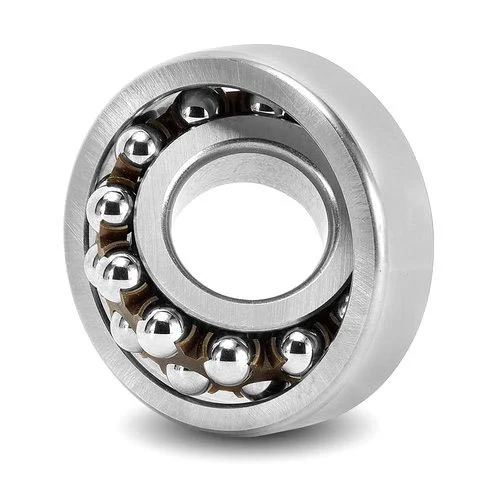
Self-Aligning Angular Contact Ball Bearings
Self-aligning angular contact ball bearings combine the features of angular contact ball bearings with self-aligning capabilities. They are designed to accommodate both axial and radial loads while allowing for shaft misalignment.
- Contact Angle Range: Available in angles ranging from 15° to 40° for optimized load distribution.
- Self-Alignment Capability: Can adjust up to 3° of misalignment to ensure smooth operation.
- Load Capacity: Designed to handle both radial and axial loads, with a typical capacity of up to 100 kN.
- Operating Speed: Suitable for high-speed applications, with speeds up to 10,000 RPM depending on the bearing type.
- Temperature Range: Can operate effectively within a temperature range of -30°C to 150°C.
Features and Benefits

- Angular Contact Capability: They handle combined radial and axial loads due to angled contact points.
- Self-Aligning Capability: The spherical outer ring raceway compensates for shaft misalignment from errors or deflections.
- High-Speed Capability: Suitable for high-speed operations with low friction and minimal heat generation.
- Reduced Maintenance: Requires less frequent adjustments compared to separate angular contact and spherical roller bearings.
- Versatility: Ideal for applications needing high load capacity and misalignment handling, like machinery and gearboxes.
Applications

- Agricultural Machinery: These bearings are used in harvesting equipment, plows, and irrigation systems, where they can accommodate misalignment and heavy loads encountered in agricultural operations.
- Conveyor Systems: Self-aligning angular contact ball bearings are employed in conveyor rollers and pulleys to ensure smooth and reliable operation under varying load and misalignment conditions.
- Industrial Gearboxes: They are utilized in industrial gearboxes and power transmission systems to handle axial and radial forces while maintaining operational efficiency and reliability.
Selection Considerations

- Load Capacity: Choose bearings with adequate load ratings to support the expected axial and radial loads in the application, considering both static and dynamic load conditions.
- Misalignment Compensation: Evaluate the degree of shaft misalignment expected during operation and select bearings with appropriate self-aligning capabilities to ensure reliable performance and extended service life.
- Operating Speed: Consider the application's speed requirements and select bearings that can maintain stable operation at the desired speeds without compromising performance or durability.
- Environmental Conditions: Assess environmental factors such as temperature variations, moisture, and contaminants to select bearings with suitable sealing and protection features for enhanced reliability and longevity.
